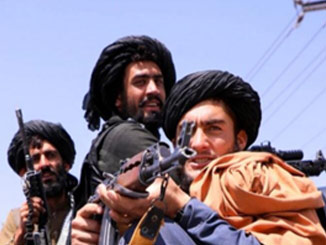

Hasht-E Subh The conflict between the Taliban and the forces of the National Resistance Front has been going on for several weeks in several districts of Badakhshan province. In the latest case, the Taliban shot dead 22 prisoners of war who were members of the National Resistance Front with their hands tied and beheaded a commander of this Front. According to the findings of the Hasht-e Subh Daily, the Taliban had previously shot more than 70 other prisoners of the National Resistance Front in Panjshir province with their hands tied. An action that has been described as a “war crime” by international organizations active in the areas of human rights. However, sources confirm that more than 35 members of the Resistance Front and about 37 members of the Taliban have been killed in these clashes.
In an interview with the Hasht-e Subh Daily, public sources say that the Taliban have shot 22 prisoners of war who were members of the National Resistance Front in Badakhshan province. According to public sources, including these 22 prisoners, 40 members of the National Resistance Front were shot dead by the Taliban militants in Badakhshan province. the Hasht-e Subh Daily has access to the pictures of the bodies of some of these dead people, as these pictures show, the Taliban have shot the eyes of these members of the National Resistance Front.
Talking to the Hasht-e Subh Daily, the sources added that the Taliban shot these 22 captives in two areas and at two different times. According to their narrative, Abdul Hamid Mujahid, one of the former commanders of the Taliban in Badakhshan province, who had recently joined the National Resistance Front with his forces and weapons, was killed in a Taliban ambush in the Kaafir Dara area of the Shewa region, after an intense confrontation. According to the sources, eight of his companions were shot dead by the Taliban militants after there were captured, and another number of his soldiers were taken to Faizabad, the capital of Badakhshan province, by the militants of this group.
The source explains: “The war against Abdul Hamid Mujahid in the Kaafir Dara area was very intense. After two or three days of intense fighting, they finally finished ammunition. The weather was also rainy, snowy, and cold. Their number was less than the Taliban too.” These sources confirm that the Taliban influenced Mr. Mujahid’s people, which “revealed” their location to the militants of the Taliban group. According to the sources, when the Taliban recognized the area, they ambushed on the road and killed Abdul Hamid Mujahid and several of his companions, and captured a number of them. Sources mention a person who infiltrated the forces of Abdul Hamid Mujahid, but the Hasht-e Subh Daily refused to mention the name of this person due to a lack of access to an authentic document.
However, sources close to “Aghai Seyed Baharuddin Yaftali”, one of the commanders of the National Resistance Front in Badakhshan province, speaking to the Hasht-e Subh Daily, say that this commander was captured and beheaded, on Wednesday, October 19, in the area of Say Dara-e Dawlatshahi of the Shewa region, which is part of the Arghanjkhah district. He was captured by the Taliban militants after he finished his ammunition. These sources have shared a videotape with the Hasht-e Subh Daily, which shows that the Taliban have beheaded Mr. Yaftali, and some of the militants of this group are dancing and stomping on the headless body of this resistance front commander. These sources confirm that after cutting off Yaftali’s head, the Taliban also shot his soldiers. But sources who are not close to this commander of the National Resistance Front add that he was ambushed by Taliban fighters on the way and after being killed, his head was cut off.
The Taliban are shooting at the forces of the National Resistance Front in Badakhshan, where about a month ago, the forces of this front had captured the Shaki district of this province. A videotape has also been published showing that the district governor of the Taliban and a number of his fighters were captured by the National Resistance Front. This front has announced that they have released the district governor of the Taliban.
Sources in Badakhshan province, talking to the Hasht-e Subh Daily, added that the Taliban have appointed Amanuddin Mansour, the commander of the air force of this group, as the governor of Badakhshan province to contain the battles of the National Resistance Front in that province. According to them, after being appointed as the governor, Amanuddin Mansour launched heavy attacks against the forces of the National Resistance Front in the Yaftal district and the Shewa region.
These sources also say that more than 37 Taliban fighters, including several famous commanders of this group, have been killed in the last week’s confrontation in Badakhshan province. According to sources, Maulvi Shaidaie, one of the Taliban leaders in Maayami district, Abdul Qadir Garnel, deputy commissioner of Maayami, Hossam and Qari Abdul Karim, commanders of Darwazha border checkpoint, and the brother of Mullah Juma from Nasi district were also killed in this province.
The Taliban have transferred the bodies of their fighters to Badakhshan provincial hospital in Faizabad city and have prohibited doctors and nurses from attending the place where they are kept. None of the employees of Badakhshan provincial hospital have access to the storage and morgue of this hospital. The sources also confirm that the Taliban have nurses and guards in this hospital and when transferring the bodies of their people, they block the area and impose strict restrictions on the patients and employees of the hospital, so that their lower ranks do not have access to the figures of the dead bodies.
Meanwhile, a source told the Hasht-e Subh Daily that the Taliban do not transfer the dead bodies of their militants daily, and therefore, the exact figures are not clear to the public. According to him, this group transfers the wounded militants to Kabul and Kunduz provinces and admits a small number of them who need urgent care to the central hospital of this province.
Sources in the National Resistance Front confirm the number of these casualties, but the Taliban did not respond to the questions of the Hasht-e Subh Daily about this matter, nor did they have any reaction about the Badakhshan province clashes.
This is even though the Taliban had previously shot dead more than 70 prisoners of the National Resistance Front in Panjshir province. the Hasht-e Subh Daily has obtained the list of people who were shot dead in three days by the Taliban militants in Panjshir province. This newspaper has already published the list of these people in a report.
The videotapes that were published of these dead people show that they were shot with their hands tied. At that time, this action of the Taliban provoked the anger of human rights organizations and institutions. Amnesty International, Human Rights Watch, and Afghanistan Independent Human Rights Commission (AIHRC) called the shooting of prisoners of war a “war crime” and asked the United Nations to prevent these actions of the Taliban.
In the latest case, the United Nations Human Rights Council has also published a report on the 12-day trip of Richard Bennett, the UN Special Rapporteur to Afghanistan. In the report of this council, which was published on Thursday, October 20, it is stated that the human rights crisis in Afghanistan is severe and the world must take immediate action.
The Afghanistan Independent Human Rights Commission has also called the killing of prisoners of war in Badakhshan province a clear example of a “war crime”. Naim Nazari, the caretaker of the Afghanistan Independent Human Rights Commission, said, “According to the four Geneva Conventions and international humanitarian law, the killing of prisoners is a clear example of a war crime.”
He adds: “Additionally, killing captives is considered reprehensible from the perspective of Islam laws, and has no religious permission. Warring parties not only do not have the right to kill prisoners, but they also do not have the right to torture and harass prisoners.”
The caretaker of the Afghanistan Independent Human Rights Commission emphasizes: “Unfortunately, this is not the first-time during wars, when captives are captured by hostile groups, they are subjected to torture and persecution. The recent incidents in Panjshir and Badakhshan provinces clearly show that war crimes have been committed. The captives have not only been tortured but have also lost their lives, which is in clear conflict with international humanitarian laws.”
Mr. Nazari states that in addition to condemning these events, the Human Rights Commission also demands from the warring groups that the approaches that violate international humanitarian laws should be stopped.
Meanwhile, an investigative body based in the United Kingdom, after examining the photos and videotapes of the killings by the Taliban in Panjshir province, says that this group shot dead 27 prisoners in this province. The findings of the “Afghan Witness: Human Rights Reporting from Afghanistan” research project, whose detailed report was published on Tuesday, October 18, indicate that the Taliban captured 27 men in Panjshir province last month and then shot them dead.

Leave a Reply